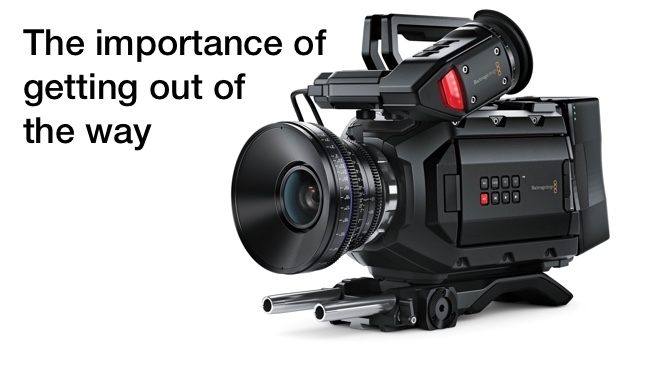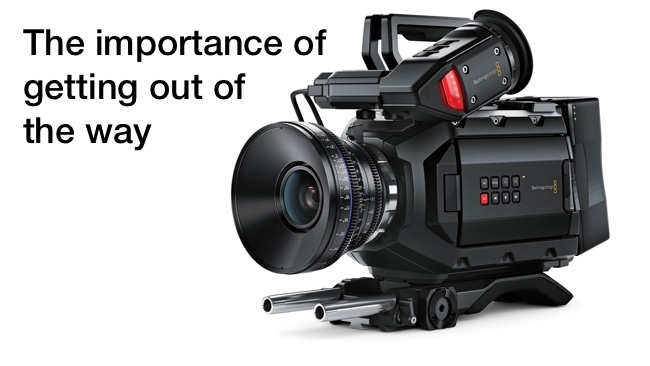
 Blackmagic Ursa Mini 4K
Blackmagic Ursa Mini 4K
Phil Rhodes takes another look at the Ursa Mini 4K and explores the greatest gift any camera can bestow on a production: letting people simply get on with the business of making films.
This is a piece provoked in part by the response to our coverage of the Ursa Mini 4K, but also (and perhaps mainly) because too many people keep their appreciation of the technology separate from their abilities as filmmakers. We shouldn't do that.
The late Sydney Pollack admits on the extra features of the DVD for The Interpreter that making a film is no fun: it's just too difficult to be enjoyable. While I hate to make an appeal to authority, it says something that an actor and director of that experience is willing to admit that making good films, even having done so many times and with great success, remains anything but easy. It is, he says, difficult to make a film that's not just embarrassing, to say nothing of presenting anything genuinely good or meaningful. Anyone who's seriously attempted to make a film will be falling over themselves to agree. The real world is sufficiently complicated that creating a convincing facsimile is monstrously difficult.
More of the same?
But at a technical level, an uncharitable observer could quite accurately state that the new 4K Blackmagic camera is, in terms of its absolute imaging capability, more or less the same camera as the company's existing 4K effort, the Production Camera. Yes, layout matters, and yes, it may sometimes matter more than number or quality of pixels. The sensor used in both the new and existing cameras are competent enough, though even Blackmagic founder Grant Petty called it "not really a digital film camera, but more of a production camera" in a 2013 post on the company's forum. He's right. It's a twelve-stop device and not, ideally, an 800 ISO one (Petty also called it "not a low light camera"). More is more, of course, and the additional headroom of the upcoming 4.6K sensor will be welcome, especially for people working in less controlled environments (and who doesn't, at least on occasion). But the venerable Viper had very similar numbers to the 4K sensor, a lot less resolution, and it produced much beautiful work.
What's actually important
What's at least as important is that it's possible to use these devices in the ways necessary to get desired results. Every five minutes spent duct-taping a DSLR to a plank is five minutes not spent optimising blocking, dirtying-down the lead so he looks like he's really been piloting a giant robot, swapping out half for quarter grid diffusion to optimise look versus exposure or going one more take so that a key focus pull is perfect.
Really good camerawork looks that way because all of the thousands of elements that make up any shot are each highly finessed. A key responsibility – almost the overriding responsibility – of production technology is to be as good as it can be then to get out of the way. Cameras are crucial, but the bigger issue is the much, much more complicated and challenging matter of making a watchable movie.
So the tech, no matter how good, needs to be out of the way and many cameras do that. The Alexa is famous, albeit large and fairly heavy; it is a crew-served device. Sony's F series has done well for its nicely-laid-out menus. Competing more directly with Blackmagic, many of JVC's nicely-laid-out cameras get out of the way, too. Film, notoriously, needs a coterie of attendants to keep its inconveniences from becoming too inconvenient. But the Ursa Mini gets it right: it gets out of the way and requires very little help to do so. This is why the lack of ND and the fiddliness of the power button are zeroed-in on for criticism. These things are either fairly minor or fixable with external toys, but they puncture the ideal.
Revisting the past
I hasten to add, too, that the greatest surprise is that it has not been done before. All that has really been done is to create an approximation of the classic BVW-300, a mainstay of Betacam SP news work, or any of its competitors or forebears. It's been widely requested for years; it could have been done at any time and many foreheads have met many desks at the realisation that, time after time, nobody seemed willing to do it. JVC, as we've said, has made some very creditable progress toward smaller, more affordable cameras with great layout.
But overall, as technology improves to the point where many cameras are highly competent, the differentiation moves to different areas. Making a camera with great ergonomics is just as deserving of praise as making one with a great sensor. The technology must get out of the way, so we can concentrate on making movies.
Tags: Production


Comments